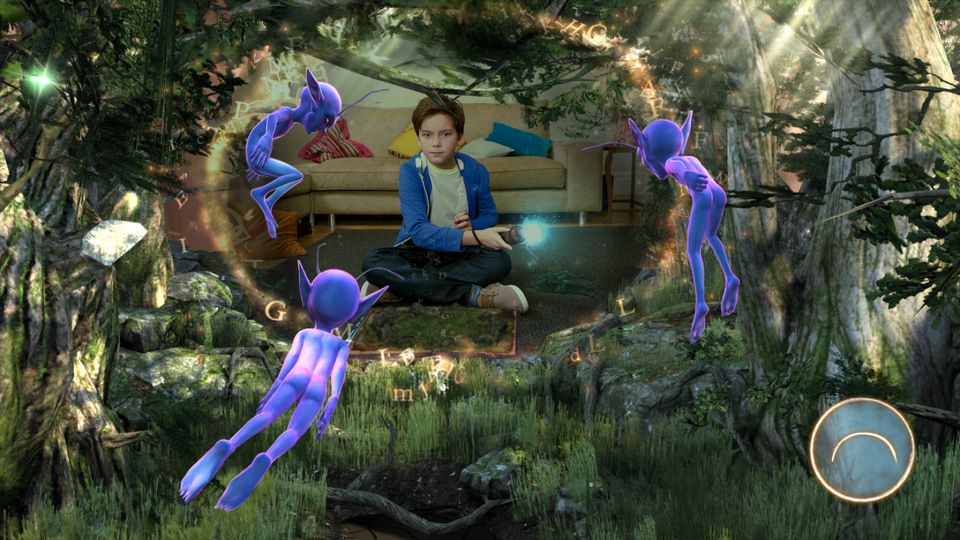We have to be honest, when we first clapped eyes on the new official accessory for the Sony PlayStation 3, the Wonderbook, at E3 in June we weren’t immediately blown away. It is, after all, simply a 12-page hardback board book with a sequence of slightly different patterns on each leaf.
Our quick take
Wonderbook: Book of Spells is an ideal example of how augmented reality can work as an entertainment tool when implemented correctly. You may be sitting on a rug in front of the telly, with an oversized and illegible tome resting in front, waving a lighted ping pong ball around and shouting “Wingardium Leviosa” at the screen, but the action on it rewards your endeavours with exciting and interesting effects.
Few other uses of AR have worked in the games world. The PS Vita has a few titles that offer promise, but ultimately require a lot of set up for little pay off. And the iPhone, iPad, Android devices and the like are only in the early days of making it a useful rather than casual tool.
Here, Book of Spells only works because of the augmented reality and its success will provoke others to follow a similar route. Sony has even revealed tie-ins with Disney and the BBC for future titles, so clearly has faith in its product. And don’t forget, you only need buy the Wonderbook once. It’s like the Singstar of, er, sitting about waving things.
Of course, you will need a PlayStation 3 Eye Camera and a Move Controller for it to work, but you can buy a pack that includes them alongside the book and “game” for £60. The Wonderbook and JK Rowling’s Book of Spells are available without the extra peripherals for a very reasonable £23.
We may have been sceptical initially, but this is one instance where we certainly don’t mind being proved wrong.
Either that or Sony has cast a Confundus spell on us. Hmmm…

PS3 Wonderbook - 4.0 / 5
| FOR | AGAINST |
|---|---|
|
|
But that’s augmented reality for you. AR targets are often boring QR code-looking shapes that mean little until you point a device at them, in the shape of a smartphone, tablet or handheld games console. In this case, it is the PlayStation 3 Eye Camera which needs to see the book, and the PS3 to be loaded with the software. Only then can the "wonder" happen.

But happen it does, certainly where JK Rowling’s Book of Spells is involved. An interactive Harry Potter experience in all but name, it is the first title in a range Sony promises will continue and an ideal retort to cynics who may snort at players waving about a PlayStation Move controller as if it were a wand. It is as magical as its theology.
Book of Spells is not a game as such, but there is plenty to interact with as you progress through the adventure. It is jam-packed with Potter mythology and offers a child - or adult, in our case, as we got as much from it - as close to the feeling of being a student at Hogwarts as you can really get sitting cross-legged in front of a TV screen.

Each double-page spread of the Wonderbook is turned into a vista of interesting stories, spell recipes and challenges as you progress. And all of the spells themselves are the same as you will have read about in Rowling’s novels or seen in the Warner Bros movie equivalents. A very pleasant narration guides you through and teaches you the movements needed to successfully cast them and there are plenty of on-screen objects to act as guinea pigs with which to do so.
There are 20 spells in total, which span over five chapters, and as there’s plenty of animated shenanigans you can get up to, that’s a lot of play time. Those worried about its longevity because of its obvious limitations – it can only be as long as the Wonderbook’s number of AR triggers will allow – need ask themselves of the longevity of a pop-up book, say, or favoured board game. Perhaps this is where its appeal differs between children and adults, but repetition is a positive element when younger kids are involved, so we can’t see a problem.

There’s also plenty of other content too. The animated stories, for example, are well-told, fairly lengthy and involve basic interaction. At the beginning of the experience you get to choose which one of the Hogwarts houses you wish to belong to - Gryffindor, Hufflepuff, Ravenclaw and, for the naughtier kiddies, Slytherin - so that will also add variety to later revisits. And the chapters throughout are based in different areas of the school, so you might want to go back to an area you particularly enjoyed, and you can go backwards through the book once you’ve completed each section.
To recap
A surprisingly pleasant experience that justifies Sony’s considerable expense and negotiation to get JK Rowling on board. Not a game as such but an interactive experience that will have you returning as much as a favourite board game or pop-up book.
